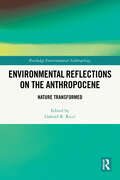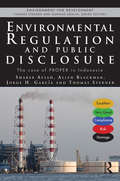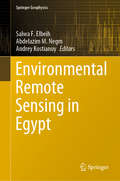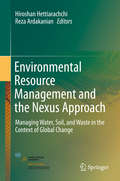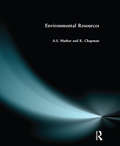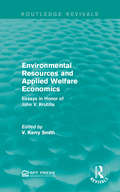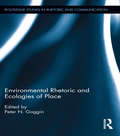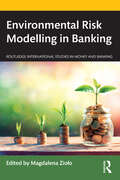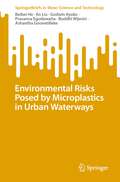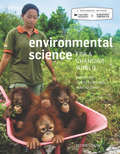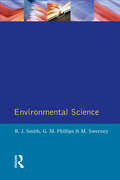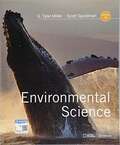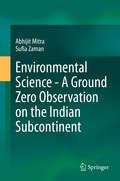- Table View
- List View
Environmental Radon: A Tracer for Hydrological Studies (Environmental Science and Engineering)
by Sukanya S. Sabu JosephThis book presents state-of-the-art techniques on radon (222Rn) in the environment, including measurement techniques in air, soil and water and its potential applications to various hydrological investigations, especially for water resources development and management. The future directions of its use are also discussed.As a radon tracer can be used to solve hydrological issues, the highlights of this book are useful for stakeholders to achieve UN Sustainable Development Goal 6, which addresses the sustainability of water resources. The most relevant target audiences are hydrologists, hydrogeologists, geologists, environmental scientists, nuclear physicists, hydraulic engineers and academicians, among others. This book also covers health implications of radon and mitigation strategies, thus creating a valuable resource for health physicists working on environmental radiation safety as well.
Environmental Realism
by Melanie Armstrong Kristan Cockerill Jennifer Richter Jordan G. OkieThis interdisciplinary book challenges current approaches to "environmental problems" that perpetuate flawed but deeply embedded cultural beliefs about the role of science and technology in society. The authors elucidate and interrogate a cultural history of solutionism that typifies expectations that science can, should, and will reduce risk to people and property by containing and controlling biophysical phenomena. Using historical analysis, eco-evolutionary principles, and case studies on floods, radioactive waste, and epidemics, the authors show that perceived solutions to "environmental problems" generate new problems, leading to problem-solution cycles of increasing scope and complexity. The authors encourage readers to challenge the ideology of solutionism by considering the potential of language, social action and new paradigms of sustainability to shape management systems. This book will appeal to scholars in multi- and interdisciplinary fields such as Environment Studies, Environmental Science, Environmental Policy, and Science, Technology, and Society Studies.
Environmental Reflections on the Anthropocene: Nature Transformed (Routledge Environmental Anthropology)
by Gabriel R. RicciIncorporating the intellectual history of disciplines from across the humanities, including environmental anthropology, philosophy, ethics, literature, history, science and technology studies, this volume provides a select orientation to the experience of nature from the ancient world to the Anthropocene.Taking its momentum from the emerging environmental humanities, this collection integrates Western, Indigenous, postcolonial, feminist and eco-spiritual perspectives that address pressing environmental concerns and reimagine the place of humans within the natural world. Across thirteen chapters, the contributors discuss the blending of environmental concerns with political and moral questions and encourage collaborative methods across disciplines to address dialectical tensions between culture and nature. They draw on a wide range of critical perspectives, provide a historical framework and speak to global environmental pressures from multiple standpoints. The global approach adopted throughout highlights the various realities of the growing ecological crisis experienced across the world. Written to appeal to a broad range of readers across the environmental humanities, this edited book will be particularly useful to academics, scholars and researchers in philosophy, anthropology, literature, history and critical theory.
Environmental Regulation and Public Disclosure: The Case of PROPER in Indonesia (Environment for Development)
by Allen Blackman Thomas Sterner Shakeb Afsah Jorge H. GarciaThis book is a remarkable case study of an environmental policy initiative for a national environmental regulatory system in the information age. In 1995 the Indonesian Ministry of Environment took the bold step to launch an environmental disclosure initiative called the Program for Pollution Control, Evaluation and Rating (PROPER). Under PROPER, environmental performance of companies is mapped into a five-color grading scale – Gold for excellent, Green for very good, Blue for good, Red for non-compliance, and Black for causing environmental damage. These ratings are then publicly disclosed through a formal press conference and posted on the internet. Not only did this simple rating scheme create a major media buzz and enhanced environmental awareness of the general public, but it also unleashed a wide range of performance incentives that showed how markets with environmental information could function in a developing country setting. The authors provide a multidisciplinary analysis of how the PROPER program harnessed the power of public disclosure to abate the problem of industrial pollution. They describe how the program has successfully improved the average environmental compliance rate from close to thrity per cent in 1995 to as high as seventy per cent in 2011. This improvement was driven primarily by information disclosure, which avoided expensive and unpredictable legal enforcement through the court system of Indonesia. The combination of institutional history and detailed economic and analyses sheds light on the role of policy entrepreneurs who laid the foundation for disclosure and transparency, despite the constraints of the Suharto regime. The PROPER program is now internationally recognized and continues to serve as a model for many developing countries.
Environmental Remote Sensing and GIS in Iraq (Springer Water)
by Abdelazim M. Negm Ayad M. Fadhil Al-QuraishiThis unique book focuses on remote sensing (RS) and geographical information systems (GIS) in Iraq. The environmental applications include monitoring and mapping soil salinity and prediction of soil properties, monitoring and mapping of land threats, proximal sensing for soil monitoring and soil fertility, spatiotemporal land use/cover, agricultural drought monitoring, hydrological applications including spatial rainfall distribution, surface runoff and drought control, geo-morphometric analysis and flood simulation, hydrologic and hydraulic modelling and the effective management of water resources. Also, this book assesses the impacts of climate change on natural resources using both RS and GIS, as well as other applications, covering different parts of Iraq. The book chapters include tens of maps extracted from the remotely sensed datasets, in addition to tables and statistical relations obtained from the results of the studies of the chapters' authors. These studies have been conducted in different parts of Iraq; in the north (Kurdistan region) with its mountainous and undulating lands, in western parts which have desert soils, and in central and southern Iraq where there are salty soils, dunes, wetlands, and marshes.The book is written by distinguished scientists from Iraq, China, USA, Italy, Iran, Germany, and the Czech Republic who are interested in the Iraqi environment. The book is therefore a useful source of information and knowledge on Iraqi environment for graduate students, researchers, policy planners, and stakeholders in Iraq as well as similar regions.
Environmental Remote Sensing and GIS in Tunisia (Springer Water)
by Abdelazim M. Negm Faiza Khebour AlloucheThis book focuses on monitoring and assessing various environmental processes in Tunisia using state-of-the-art remote sensing and GIS technologies. In addition to addressing the diversity of Tunisian landscapes and providing spatial analysis of natural, cultivated and urbanized environments. It presents and discusses several case studies on integrated RS / GIS approaches for mapping, modeling, monitoring and evaluation. Moreover, in this volume authored by experts in the topic from Tunisia and other countries, authors assess the agro-environmental applications from Tunisia and offer different methods and applications to environmental processes and risks including drought, degradation, flood, planning, Yield estimation, dust storm detection, dry land vulnerability, wetland dynamics and others. The material presented here will help decision-makers plan sustainable landscape and agricultural management policies that preserve biodiversity and contribute to achieving sustainability goals and for researchers, it will expose methodological approaches used in different fields of research. Graduate students and Practionioner engineers working in the field of RS/GIS will also benefit from the book. The book ends with a set of conclusions and recommendations to support researchers underscoring the need for further research in this area.
Environmental Remote Sensing and Systems Analysis
by Ni-Bin ChangUsing a systems analysis approach and extensive case studies, Environmental Remote Sensing and Systems Analysis shows how remote sensing can be used to support environmental decision making. It presents a multidisciplinary framework and the latest remote sensing tools to understand environmental impacts, management complexity, and policy implicatio
Environmental Remote Sensing in Egypt (Springer Geophysics)
by Abdelazim M. Negm Salwa F. Elbeih Andrey KostianoyThis book presents a comprehensive selection of applications employed in environmental remote sensing using optical and thermal infrared satellite-sensors aiming to map natural resources, crops, groundwater, surface water, aquatic ecosystem, land degradation, air quality, renewable energy, regional resources, and climate-related geophysical processes. The technologies presented in this book also include satellite images, space-borne radar sensors focusing on the most versatile one, data from synthetic aperture radar (SAR), scatterometers and radar altimeters in Egypt. This volume also presents a thorough explanation of the remote sensing role showing physical fundamentals of the climate change phenomenon including gas emissions, and the impact on resources concerning the sustainable development of Egypt. Besides, the book includes an analysis of oil pollution in both Mediterranean and Red Seas This book is intended for environmental policymakers working in Egypt as well as scientists working with remote sensing technologies in highly populated arid regions.
Environmental Resource Management and the Nexus Approach
by Reza Ardakanian Hiroshan HettiarachchiThis book elaborates how water, soil, and waste may be managed in a nexus and how this approach may help combat global change. In addition to providing a brief account on nexus thinking and how it may help us tackle issues important to the world community such as food security, the book presents the environmental resource perspective of three main aspects of global change: climate change, urbanization, and population growth. Taking as its point of departure the thematic discussions of the Dresden Nexus Conference (DNC 2015) held in March 2015, the book presents the perspectives of a number of thought leaders on how the nexus approach could contribute to sustainable environmental resource management. Thefirst chapter provides an introduction to the issues and consent of the book. Chapters 2 and 3 focus on climate change adaptation. Chapters 4 and 5 discussthe role of urbanization as a main driver of global change. The last twochapters of the book present ideas on how the nexus approach may be used tocope with population growth and increased demand for resources.
Environmental Resources
by A.S. Mather K. ChapmanEnvironmental Resources provides a comprehensive text for undergraduate resource management courses. It begins with an introduction to natural and environmental resources and then considers them in the context of politics, time and space.
Environmental Resources Use and Challenges in Contemporary Southeast Asia: Tropical Ecosystems In Transition (Asia in Transition #7)
by Mario Ivan Lopez Jafar SuryomenggoloThis edited volume introduces dynamic approaches to the study of Southeast Asia’s environmental diversity from different disciplinary perspectives at the interface between the natural and social sciences. It brings together research on the region’s environmental resource use and shared ecological challenges in the context of present day globalization to offer insights for possible future directions. The book introduces unique approaches to the study of Southeast Asia’s environmental changes and resource management under the influence of intensifying economic change in the region. It also examines the slow erosion of Southeast Asia’s rich environment and addresses serious issues such as the decrease in biodiversity and tropical forests, and the degradation of peat lands. At the same time, it discusses the social issues that are tied to energy-dependent growth and have intensified over the last two decades. It also analyzes the new roadmaps being created to protect, conserve, and manage the environment. By investigating the many ecological issues surrounding us, the volume brings to light the constant struggles we face while trying to develop a more inclusive and equitable approach to natural resources governance. This volume is relevant for students, academics and researchers who have an interest in the Southeast Asian environment and the way in which we use and interact with it.
Environmental Resources and Applied Welfare Economics: Essays in Honor of John V. Krutilla (Routledge Revivals)
by V. Kerry SmithThis book, first published in 1988, provides an overview of the diverse work that was being done in applied and theoretical environmental and resource economics. Some essays reflect upon the background of the work of John Krutilla, one of the founders of Resources for the Future and a leading scholar of environmental economics, and the development of the field to date. Other essays examine and convey findings on particular resource problems and theoretical issues and resource policies and the practice of applied welfare economics. This title will be of interest to students of economics and environmental studies.
Environmental Restoration: Proceedings of F-EIR Conference 2021 (Lecture Notes in Civil Engineering #232)
by Jorge De Brito Deepankar Kumar AshishThis book gathers peer-reviewed contributions presented at the F-EIR Conference 2021, Environment Concerns and its Remediation, held in Chandigarh, India, on October 18-22, 2021. The respective papers focus on environmental monitoring and remediation, and cover topics such as efficiency in the use of energy, water, resources and human capital, waste minimization & management, durability and sustainability of building materials, green technologies, environmental sustainability and resilience, renewable energy, prevention and management of water pollution, life cycle assessment, and climate change. Accordingly, the book offers a valuable, up-to-date tool and essential overview of the subject for scientists and practitioners alike, and will inspire further investigations and research.
Environmental Restoration: Science And Strategies For Restoring The Earth
by John BergerEnvironmental Restoration is the product of a ground-breaking conference on ecological restoration, held in January 1988 at the University of California, Berkeley. It offers an overview from the nation's leading experts of the most current techniques of restoration, including examples of the complex and subtle biological interactions we must understand to ensure success.Chapters cover restoration of agricultural lands, barrens, coastal ecosystems, prairies, and range lands. Additional sections address temperate forests and watersheds, mined lands, soil bioengineering, urban issues including waste treatment and solid, toxic, and radioactive waste management. The book also covers restoration of aquatic systems, includes chapters on strategic planning and land acquisition, and provides examples of successful projects.
Environmental Rhetoric and Ecologies of Place (Routledge Studies in Rhetoric and Communication)
by Peter N. GogginUnderstanding how rhetoric, and environmental rhetoric in particular, informs and is informed by local and global ecologies contributes to our conversations about sustainability and resilience — the preservation and conservation of the earth and the future of human society. This book explores some of the complex relationships, collaborations, compromises, and contradictions between human endeavor and situated discourses, identities and landscapes, social justice and natural resources, movement and geographies, unpacking and grappling with the complexities of rhetoric of presence. Making a significant contribution to exploring the complex discursive constructions of environmental rhetorics and place-based rhetorics, this collection considers discourses, actions, and adaptations concerning environmental regulations and development, sustainability, exploitation, and conservation of energy resources. Essays visit arguments on cultural values, social justice, environmental advocacy, and identity as political constructions of rhetorical place and space. Rural and urban case studies contribute to discussions of the ethics and identities of environment, and the rhetorics of environmental cartography and glocalization. Contributors represent a range of specialization across a variety of scholarly research in such fields as communication studies, rhetorical theory, social/cultural geography, technical/professional communication, cartography, anthropology, linguistics, comparative literature/ecocriticism, literacy studies, digital rhetoric/media studies, and discourse analysis. Thus, this book goes beyond the assumption that rhetorics are situated, and challenges us to consider not only how and why they are situated, but what we mean when we theorize notions of situated, place-based rhetorics.
Environmental Rights: Critical Perspectives (Esri Working Papers In Policy Studies)
by Chris MillerEnvironmental Rights offers new perspectives on contemporary debates over rights and environmental issues. It draws on key theories of contemporary philosophers and jurists and case reports from decisions in English, European and US courts. It also examines recent developments within environmental law and policy in the UK and the EU. Specific rights of the individual are examined - the right to clean air and water, access to information, the right to participate in environmental decisions - as well as the practical obstacles to the exercising of these rights.
Environmental Risk Modelling in Banking (Routledge International Studies in Money and Banking)
by Magdalena ZiołoEnvironmental risk directly affects the financial stability of banks since they bear the financial consequences of the loss of liquidity of the entities to which they lend and of the financial penalties imposed resulting from the failure to comply with regulations and for actions taken that are harmful to the natural environment. This book explores the impact of environmental risk on the banking sector and analyzes strategies to mitigate this risk with a special emphasis on the role of modelling. It argues that environmental risk modelling allows banks to estimate the patterns and consequences of environmental risk on their operations, and to take measures within the context of asset and liability management to minimize the likelihood of losses. An important role here is played by the environmental risk modelling methodology as well as the software and mathematical and econometric models used. It examines banks’ responses to macroprudential risk, particularly from the point of view of their adaptation strategies; the mechanisms of its spread; risk management and modelling; and sustainable business models. It introduces the basic concepts, definitions, and regulations concerning this type of risk, within the context of its influence on the banking industry. The book is primarily based on a quantitative and qualitative approach and proposes the delivery of a new methodology of environmental risk management and modelling in the banking sector. As such, it will appeal to researchers, scholars, and students of environmental economics, finance and banking, sociology, law, and political sciences.
Environmental Risk and Resilience in the Changing World: Integrated Geospatial AI and Multidimensional Approach (GIScience and Geo-environmental Modelling)
by Atiqur Rahman Swapan Talukdar Somnath Bera G. V. Ramana Atish PrasharThis book provides huge knowledge and data in the fields of geospatial sciences, earth environmental sciences, humanities, and social sciences, which target a diverse range of readers, such as academics, scientists, students, environmentalists, meteorologists, urban planners, remote sensing, and GIS experts. Earth environment (ecological envelope of geosphere, biosphere, hydrosphere, atmosphere and cryosphere) faces a significant challenge from different risks and threats due to due to rapid changes in global land use, population increase and pollution. They might drastically impair the ecosystem's ability to maintain long-term service levels while bolstering the economic, social, and environmental pillars of sustainable development. Therefore, risk assessment (RA) has lately become a prominent research topic and a powerful mechanism for enforcing legal activities-related environmental restoration and health improvements to do sustainable development. The United States Environmental Protection Agency (USEPA) first used the risk assessment approach in 1980, and since then, it has expanded and become standard practice in many areas of ecological research. Some practices are air quality assessment, land degradation assessment, natural hazards risk assessment, urban surface ecological health condition, wetland and forest health assessment and drinking water quality assessment. However, recently risk assessment alone is not sufficient to propose any sustainable management plans. Also, there is no universal strategy for conducting risk assessments, and insufficient expertise with the methodology may result in erroneous findings. Therefore, scientists are increasingly interested in developing resilience strategies with AI and geospatial-based risk assessment to lower environmental risk. Different resilience approaches make different assumptions about the system dynamics involved in resilience-based environmental risk and impact assessment. Therefore, this book seeks to showcase the most current advances in risk and hazards assessment of environments with resilience strategies to mitigate the prevailing environmental issues with the help of remote sensing, GIS, artificial intelligence, and state-of-the-art frameworks like PSR, VIOR, nature-based solutions.
Environmental Risks Posed by Microplastics in Urban Waterways (SpringerBriefs in Water Science and Technology)
by An Liu Ashantha Goonetilleke Prasanna Egodawatta Buddhi Wijesiri Beibei He Godwin AyokoThis book presents comprehensive knowledge regarding the spatial and temporal distributions, influential factors, interactions with coexisting contaminants, migration behavior, and environmental risk posed by microplastics (MPs) in urban waterways. It provides a novel theoretical approach for the combined risks from MPs and coexisting contaminants, and advanced three-dimensional modeling techniques for different MPs’ dispersal and transport behaviors in urban waterways. Additionally, this book presents a scientifically robust investigation on the correlations between various influential factors and heterogeneity in relation to MP presence in river systems. The new knowledge presented would be of particular interest to readers such as urban water management professionals, urban plastic waste regulators, decision-makers, urban planners, and water environment quality model developers, as it provides practical solutions and recommendations for plastic-polluted river quality improvement from a risk management perspective.
Environmental Science
by Anne Houtman Susan Karr Jeneen InterlandiFollowing real people and real science, Environmental Science for a Changing World provides a unique context for showing students how science works and how to think critically about environmental issues. Chapters don't merely include interesting stories--each chapter is an example of science journalism at its best, combining Scientific American-style writing, layout, and graphics to tell one compelling story that exemplifies important concepts and issues. This approach has proven so effective, that instructors using the book report a dramatic increase in the number of students who read the assignments and come to class ready to participate. This updated new edition features new stories, updated scientific coverage, and enhanced Infographics--the book's signature visual study tool that combines memorable images, step-by-step callouts, and now, questions that foster scientific literacy.
Environmental Science
by Prentice-Hall Staff WithgottTeaching environmental science is much more than just communicating facts and information. It's about engaging and motivating students. It's about helping them to better understand how and why their actions--and those around them--impact the world in which they live. <P><P> Environmental Science: Your World, Your Turn is a new high school program that brings the outside world into the classroom--making the science personal, actionable, and empowering for each student.
Environmental Science (Fifteenth Edition)
by Scott Spoolman G. Tyler MillerAuthors Tyler Miller and Scott Spoolman have partnered with the National Geographic Society to develop a text that will equip you with the inspiration and knowledge you need to make a difference solving today's environmental issues. Exclusive content highlights important work of National Geographic Explorers and Grantees and features over 180 new photos, maps, and illustrations that bring course concepts to life. Using this empowering book, you will learn how nature works, how you interact with it, and how you can use various scientific principles based on how nature has sustained life on the earth for billions of years to live more sustainably.
Environmental Science (Longman Technician Series)
by M Sweeney B. J. Smith G M PhillipsFirst published in 1983. This book aims to cover the requirements for the Business and Technician Education Council Level Three & Four Units in Environmental Science. At the same time it was recognised that there was a real need for a suitable book for those studying Building, Quantity Surveying, Architecture and Environmental Health at 1st degree level. This book should therefore form a useful first year introductory text for both ‘A’ level and BTEC entrants. The book contains a large number of worked examples in the text as well as many student questions at the end of each chapter. Experiments have been included, not with the intention of being exhaustive, but to give ideas. Some areas of work lend themselves to student practical work better than others so that some inbalance is inevitable. ‘Environmental Science’ should give students an introduction to the environmental problems in construction and the methods which may be used to provide a satisfactory and economic solution.
Environmental Science (Mindtap Course List Series)
by G. Tyler Miller Scott E. SpoolmanThe 16th Edition of ENVIRONMENTAL SCIENCE is "inspiring people to care about the planet." Partnering with National Geographic Learning, the authors Tyler Miller and Scott Spoolman deliver a text that equips and inspires you with the tools and knowledge to make a difference solving today's environmental issues. Exclusive content highlights important work of National Geographic explorers and grantees and features vivid photos, maps and illustrations that bring course concepts to life. Using sustainability as their central theme, the authors emphasize natural capital, natural capital degradation, solutions, trade-offs and the importance of individuals. In return, you learn how nature works, how you interact with it and how humanity can continue to sustain its relationship with the earth by applying nature's lessons to economies and individual lifestyles.
Environmental Science - A Ground Zero Observation on the Indian Subcontinent: A Ground Zero Observation On The Indian Subcontinent
by Abhijit Mitra Sufia ZamanThis book provides a cross-sectoral, multi-scale assessment of different environmental problems via in-depth studies of the Indian subcontinent. Data collected from different ecosystems forms a strong foundation to explore the topics discussed in this book. The book investigates how mankind is presently under the appalling shadow of pollution, climate change, overpopulation and poverty. The continuing problem of pollution, loss of forests, disposal of solid waste, deterioration of environment, global warming and loss of biodiversity have made nations aware of environmental issues. Many countries are desperately trying to move away from this adverse situation through technological development and policy level approaches. Through a number of case studies the authors provide details of ground level observations of the most environmentally stressed regions in the Indian subcontinent and beyond.


